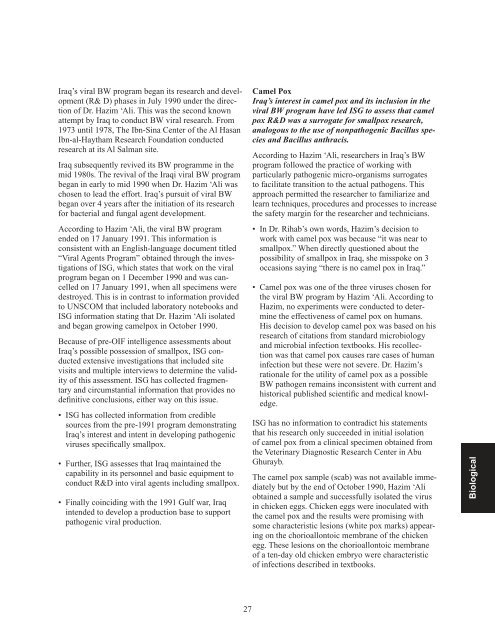Comprehensive Report
GPO-DUELFERREPORT-3
GPO-DUELFERREPORT-3
- No tags were found...
Create successful ePaper yourself
Turn your PDF publications into a flip-book with our unique Google optimized e-Paper software.
Iraq’s viral BW program began its research and development<br />
(R& D) phases in July 1990 under the direction<br />
of Dr. Hazim ‘Ali. This was the second known<br />
attempt by Iraq to conduct BW viral research. From<br />
1973 until 1978, The Ibn-Sina Center of the Al Hasan<br />
Ibn-al-Haytham Research Foundation conducted<br />
research at its Al Salman site.<br />
Iraq subsequently revived its BW programme in the<br />
mid 1980s. The revival of the Iraqi viral BW program<br />
began in early to mid 1990 when Dr. Hazim ‘Ali was<br />
chosen to lead the effort. Iraq’s pursuit of viral BW<br />
began over 4 years after the initiation of its research<br />
for bacterial and fungal agent development.<br />
According to Hazim ‘Ali, the viral BW program<br />
ended on 17 January 1991. This information is<br />
consistent with an English-language document titled<br />
“Viral Agents Program” obtained through the investigations<br />
of ISG, which states that work on the viral<br />
program began on 1 December 1990 and was cancelled<br />
on 17 January 1991, when all specimens were<br />
destroyed. This is in contrast to information provided<br />
to UNSCOM that included laboratory notebooks and<br />
ISG information stating that Dr. Hazim ‘Ali isolated<br />
and began growing camelpox in October 1990.<br />
Because of pre-OIF intelligence assessments about<br />
Iraq’s possible possession of smallpox, ISG conducted<br />
extensive investigations that included site<br />
visits and multiple interviews to determine the validity<br />
of this assessment. ISG has collected fragmentary<br />
and circumstantial information that provides no<br />
definitive conclusions, either way on this issue.<br />
• ISG has collected information from credible<br />
sources from the pre-1991 program demonstrating<br />
Iraq’s interest and intent in developing pathogenic<br />
viruses specifically smallpox.<br />
• Further, ISG assesses that Iraq maintained the<br />
capability in its personnel and basic equipment to<br />
conduct R&D into viral agents including smallpox.<br />
• Finally coinciding with the 1991 Gulf war, Iraq<br />
intended to develop a production base to support<br />
pathogenic viral production.<br />
Camel Pox<br />
Iraq’s interest in camel pox and its inclusion in the<br />
viral BW program have led ISG to assess that camel<br />
pox R&D was a surrogate for smallpox research,<br />
analogous to the use of nonpathogenic Bacillus species<br />
and Bacillus anthracis.<br />
According to Hazim ‘Ali, researchers in Iraq’s BW<br />
program followed the practice of working with<br />
particularly pathogenic micro-organisms surrogates<br />
to facilitate transition to the actual pathogens. This<br />
approach permitted the researcher to familiarize and<br />
learn techniques, procedures and processes to increase<br />
the safety margin for the researcher and technicians.<br />
• In Dr. Rihab’s own words, Hazim’s decision to<br />
work with camel pox was because “it was near to<br />
smallpox.” When directly questioned about the<br />
possibility of smallpox in Iraq, she misspoke on 3<br />
occasions saying “there is no camel pox in Iraq.”<br />
• Camel pox was one of the three viruses chosen for<br />
the viral BW program by Hazim ‘Ali. According to<br />
Hazim, no experiments were conducted to determine<br />
the effectiveness of camel pox on humans.<br />
His decision to develop camel pox was based on his<br />
research of citations from standard microbiology<br />
and microbial infection textbooks. His recollection<br />
was that camel pox causes rare cases of human<br />
infection but these were not severe. Dr. Hazim’s<br />
rationale for the utility of camel pox as a possible<br />
BW pathogen remains inconsistent with current and<br />
historical published scientific and medical knowledge.<br />
ISG has no information to contradict his statements<br />
that his research only succeeded in initial isolation<br />
of camel pox from a clinical specimen obtained from<br />
the Veterinary Diagnostic Research Center in Abu<br />
Ghurayb.<br />
The camel pox sample (scab) was not available immediately<br />
but by the end of October 1990, Hazim ‘Ali<br />
obtained a sample and successfully isolated the virus<br />
in chicken eggs. Chicken eggs were inoculated with<br />
the camel pox and the results were promising with<br />
some characteristic lesions (white pox marks) appearing<br />
on the chorioallontoic membrane of the chicken<br />
egg. These lesions on the chorioallontoic membrane<br />
of a ten-day old chicken embryo were characteristic<br />
of infections described in textbooks.<br />
Biological<br />
27


